Dogs may become fearful or have a strong emotional reaction to loud noises such as thunderstorms, fireworks, or garbage trucks. Some dogs fear being alone, while others become reactive when confined.
Different dogs have different temperaments and will react differently to various stimuli. Shy dogs may escape or run away at the first sign of trouble, while more confident dogs may decide to stay and fight. A naturally confident dog will recover from new and fearful experiences much faster than a naturally shy dog.
Young dogs tend to be more open to new experiences, and bounce back more quickly. This is why we want to socialize our dogs to many positive new experiences when they are young, so that they will grow up to be a confident and balanced adult dog.
However, we can train any dog to better handle stress or fear, and become more confident. All it takes is time, patience, and a lot of repetition. One of the best ways to calm a fearful or reactive dog is through the desensitization process.

Dog Desensitization – A Good Way to Calm a Dog
The desensitization process works by initially exposing a dog to very low levels of the problem stimulus. Once the dog becomes accustomed to the low level stimulus, we very slowly increase its intensity. Over time, our dog will learn to tolerate and be calm at even higher levels of the reactive stimulus.
Patience is key because we do not want to raise the stimulus potency too quickly and cause our dogs to lose control. Frequent loss of control (from fear or over-excitement) will not only set back our desensitization work, but also make our dog mistrust us, and become even more reactive.
Dog desensitization exercises are commonly combined with counter-conditioning techniques.

In addition to getting our dog calm and comfortable with the problem stimulus (desensitization), we also help him re-associate a previously negative stimulus with something positive (counter-conditioning).
Counter conditioning is achieved by engaging our dog in focus/eye-contact training and other simple dog obedience commands (e.g. Sit) during the desensitization process. When our dog stays calm and follows our commands we reward him well with affection and his favorite treats. In this way our dog learns to re-associate the ‘bad’ stimulus with calmness, yummy treats, and affection from us.
Note – We only reward good behaviors, i.e. our dog following commands and staying calm. Do not give treats or affection to your dog when he loses control, or when he is showing fear symptoms. If you do this with the wrong energy or technique, it will only encourage his reactivity and fears. Instead, just remove him to a quiet area where he can calm down on his own.
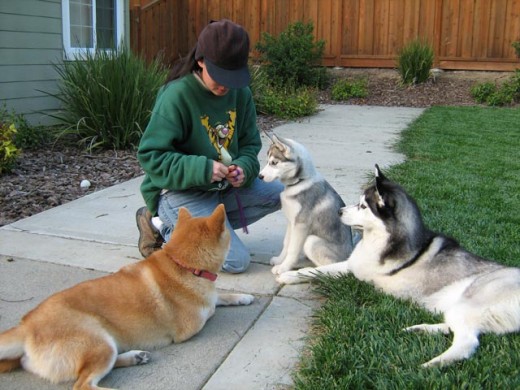
Calm a Dog to Noise

For a dog that is fearful or over-excited of loud noises such as fireworks or thunderstorms, the trigger stimulus is the noise. Therefore, our noise desensitization session would go something like this –
- We get a recording of fireworks or a thunderstorm and then play it (in loop mode) on our stereo at a very low volume. Make sure that the initial volume is low enough that our dog is able to stay calm.
- We engage our dog in focus and obedience exercises while the recording is playing and reward him well for staying calm and following commands.
- If everything is well, we increase the volume of our recording slightly and repeat step 2.
- If our dog stops accepting treats, or is no longer able to focus then we have moved forward too quickly. At this point we want to lower our volume by a few notches. Once our dog is calm again, we can repeat step 2.
- It is important to keep desensitization sessions short, positive, and rewarding. In this way, our dog will start to associate fireworks and thunderstorms with positive experiences rather than something that is threatening and stressful.
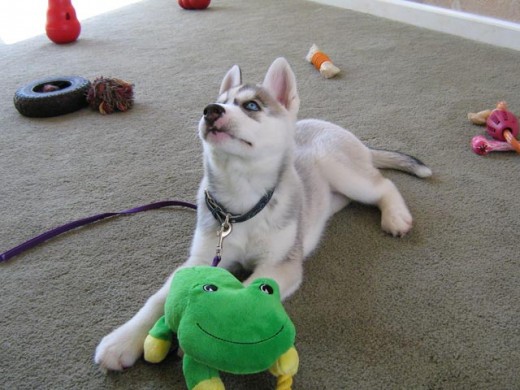
Calm a Dog to People

Dogs may also become anxious or over-excited when people come into their space and pet or hug them. Dogs are not humans, and they do not have the same communication cues as we do. When meeting a new dog, especially a shy dog, it is best to first ignore the dog and let him approach us.
We can help our dog become less fearful of people by desensitizing him using distance, focus, and rewards –
- Ask a friend to sit under a tree in our backyard and read a book.
- Meanwhile, we have our dog on-leash and stand far enough away from our friend that our dog is calm and relaxed.
- We get our dog’s focus and do some simple obedience exercises. He gets rewarded for staying calm and working together with us.
- If all is well, we move one step toward our friend and repeat step 3.
- It is important that our friend totally ignores the dog, which means no talking and no eye-contact. Eye-contact can be seen as an invitation to interact, or as a threat, especially by a shy dog. Either way, it can trigger an excited or fearful response.

As always, we want to keep desensitization sessions short, fun, and rewarding. In this way, our dog will learn to re-associate people with calmness and positive experiences.
- After several sessions, we may get close enough to our friend that she can throw some high priority treats to our dog. However, it is still important not to initiate eye-contact.
- If our dog is calm and does not have a bite history, we can let him come over and sniff our friend (still no eye-contact).
- Once our dog is comfortable with the scent of our friend and is calm, then we can bring her back a few paces and repeat the desensitization exercise with brief periods of eye contact.

In later stages we can repeat the desensitization process for –
- A person who is moving slowly.
- A person wearing unusually clothing, big hats, or carrying an umbrella.
- A person on a skateboard or bicycle.
- A person who is talking softly.
- A person who is talking in a high-pitched tone.
- A threatening person who is talking loudly.
The more things we desensitize our dog to, the more confident he will become and the more prepared he will be to handle new experiences.
However, patience is extremely important. The key to the desensitization process is to help dogs re-associate previously stressful or highly emotional situations with something calm and positive. Going too fast can scare our dog and cause him to become even more reactive of people.
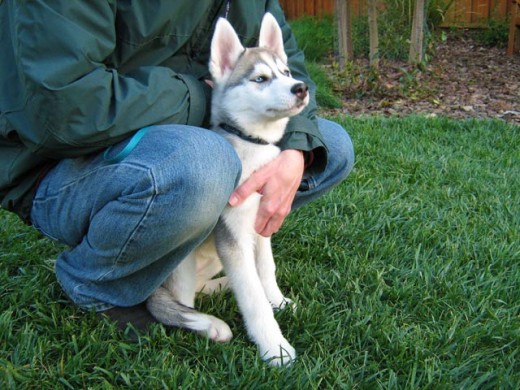
Calm a Dog to Confinement

Some dogs may get reactive when they are first confined in a crate. Confinement can be stressful because the dog loses his ability to escape if a threat should arise.
Before confining a dog in a crate for any length of time, it is best to first get the dog calm and desensitized to the crate.
- We start by showing the crate to our dog and letting him smell and examine it.
- Next we put some food near the entrance of the crate and let our dog step in to eat it.
- When he is comfortable with that, we throw some food deeper into the crate.
- We continue until our dog is cheerfully going into the crate on his own. At this point, make sure to leave the crate door open so our dog can move into and out of the crate freely.
- Once our dog is calmly moving into and out of the crate, we can close the door briefly. Wait one second, and then open the door again.
Finally, we slowly lengthen the time that our dog spends in the crate.
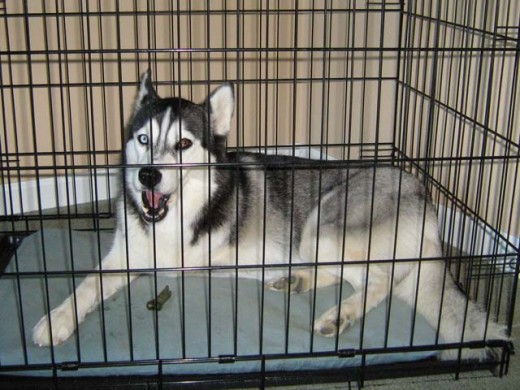
Desensitization vs. Flooding
In addition to desensitization, there is another technique called flooding that can also be used to deal with dog anxieties and fears.
With desensitization we expose a dog slowly to low amounts of the fear stimulus. We get the dog comfortable with the low level stimulus, then gradually train him to accept greater levels.
Flooding, on the other hand, exposes a dog to large amounts of the fear stimulus right away. The dog is then forced to experience the fear stimulus until he calms down.
Like us, a dog’s body can only keep pumping adrenalin for a fixed amount of time, i.e. there is a time limit to a dog’s fear response or panic attack. Theoretically, both human and dog will calm down after some time, realize that there is nothing to fear, and start to associate that new feeling of ease with the previously fearful stimulus.
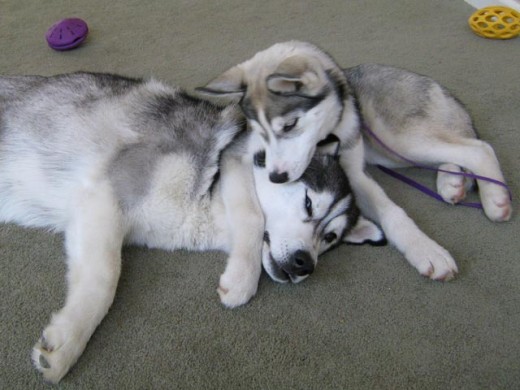
Flooding may be faster than the desensitization process, but it is risky, more traumatic, and may cause the dog to just shut down and stop responding.
Flooding is a psychotherapeutic method for overcoming phobias. This is a faster, yet less efficient and more traumatic, method of ridding fears when compared with systematic desensitization.
~~[Wikipedia]
For this reason, most animal behaviorists recommend using desensitization and counter conditioning methods to treat dog anxieties and fears. Desensitization may take more patience and more time, but it is safer, the results are long-lasting, and it helps to build a strong bond between us and our dog that is based on trust and respect.
The key to everything is patience. You get the chicken by hatching the egg, not by smashing it.
~~[Arnold H. Glasgow]

my 7 year old Biscon hears n noises from my cell phone and she starts to tremble ( almost out of control ) What can i do to help he get through this. Thankm You
Hi I have been doing desensitization/counter-conditioning with my year and a half old pitbul mix who was reactive and aggressive towards strangers. I have been doing it for about a month now and I am seeing a little bit of improvement but he is still reacting at times. My question is how long does the desensitization/counter-conditioning process usually take?
Hello.
Four variables are on the table: trainer, trainee, stimulus and reward.
You can easily control stimulus and reward. Let’s work on them.
If the stimulus is strong enough, any dog will react to it. Every dog is a reactive dog. Some have a higher threshold. Let it sink for a moment.
Desensitization ain’t a process with a definite result, it’s a method to adequate the threshold of a dog’s response to a stimulus. How long does it take? We can train a dog in a day to love a popping balloon (Fido will have a treat every time a balloon pops nearby, then on him, then when he pops the thing himself), but it takes closer to a year to prepare a dog to a war scene (Fido eats his daily ration if and only if there’s strong gunfire around). But it can be done.
Avoidance is still the most human-convenient dog response to a perceived threat. The alternative is fear aggression. Both are siamese twins in the called Defense Drive.
If the reward is strong enough, any dog will bite the bullet to chew/play. Regular kibble is enough for a highly food driven Labrador or German Shepherd (due to genetics) or for my Belgian Malinois (that has eaten nothing but kibble in her life, from my hand, no exception). You’d need tastier food for a pet.
You can speed up the whole process with a systematic approach, e.g., for the same high stimulus give high value rewards on a fixed schedule, then on a variable schedule, then regular dog food or play time; then go for a higher stimulus and keep on the track until the results fit your fancy.
Regards,
Shibe San
Hi, i have 18 months old stafford who became reactive about a month ago, i dont know why i havent seen someone to do him harm,…when i walk him and strangers come close he begins to pull/bark/growl/jumps at them, even when he’s in the yard and someone walks by he begins to bark very aggresive and runs toward the fence usually if that person talks very loud, also he runs towards bycicles. He’s not aggressive with other dogs or with someone he knows, only with strangers and only adults not children. He also pulls when i walk him, i tried to stop everytime he pulls and/or changing directions but theres no improvement. And there’s his annoying habbit to jump on me and other family members when he wants to play, i tried to turn back and raise my arms but that doesnt work, how to stop him from jumping on me and others…? he’s also very afraid of fireworks he begins to panic and run in the house very fast when something like that happens
For the pulling have you tried a harness.
Some if his reactions sound exactly what my dog was doing, it turned out to be a thyroid problem. If you do get the test done do it through Dr. Jean Dodds, she is the thyroid expert! http://www.hemopet.org
My dog is much better since she is now on medication for thyroid just switched her to RAW diet. Even better. Good luck!
i have a sheltie and my dog is scared of everything… she loves me but if i make her do something or stand by someone she doesnt like she shakes and acts up.. she hides under tables.. she doesnt listen to anyone but me and i dont know how she got this way or how to fix it, i feel like she doesnt fully trust me and i dont know how to change that.
I gained my Shiba Inu’s trust through consistency and setting him up for success. I create a fixed routine, consistent rules, and a consistent way of communication. In this way, he knows exactly what to expect from me and what I expect from him in return. This creates certainty, and certainty helps to reduce stress and anxiety.
I do desensitization exercises with my dog, in a structured and controlled environment. I start small with a very weakened version of the scary stimulus, so that my dog is able to remain calm, and learn positive behaviors from the experience. The more calm and successful experiences my dog has, the more confidence, trust, and positive associations he forms. Similarly, panic attacks and reactive experiences will undermine that confidence and trust, set back our training, and worsen his anxiety behaviors.
Therefore, a very important part of helping my dog with his anxiety and earning his trust is to manage his environment very carefully. I try to always set him up for success and I *do not* expose him to situations that he is not ready for. I talk more about how I desensitize my dog to people in the article above.
These ASPCA articles have more information common anxieties-
https://www.aspca.org/pet-care/virtual-pet-behaviorist/dog-behavior/fear-people
https://www.aspca.org/pet-care/virtual-pet-behaviorist/dog-behavior/neophobia-fear-new-things
https://www.aspca.org/pet-care/virtual-pet-behaviorist/dog-behavior/fear-other-animals
https://www.aspca.org/pet-care/virtual-pet-behaviorist/dog-behavior/fear-noises
Given what you describe, I would get help from a good, positive-based trainer as soon as possible.
https://www.aspca.org/pet-care/virtual-pet-behaviorist/finding-professional-help
https://apdt.com/pet-owners/choosing-a-trainer/
Meanwhile, I would manage the dog’s environment very carefully, always set her up for success, and not expose her to situations that she is not ready to handle. Building trust with my dog involves consistency, management, and protecting him from what he views as threats.
More on how I build a strong bond with my dog.
Cooper is our 8 month boxer/lab who is a complete joy. He has been socialized since 9 weeks with people and other dogs but because we don’t know a lot of children, he has had very limited exposure. Two nights ago, we were on our nightly walk and a child on a scooter came to close to him; he got spooked and bolted out of his collar and ran. I thought it was a one off, but tonight we were on our walk again, he was anxious but I thought it was just because of other night. We walked through the park and a child was running about 10 feet away and Cooper bolted again. This time thankfully, he was still in his collar and I had a hold of him. I want him to feel comfortable around everyone. Is it too late for him to be comfortable around children? He is delightful in every other way. I don’t think he will bite as he bolts as oppose to charging, but I want him not too be in fear. At some point, we are hoping to have kids around and I want him to be able to enjoy their company.
I do desensitization exercises with my dog to get him used to different types of people. We do training in a structured and controlled environment, and I always make sure that everyone is safe. This is, of course, especially important with children. I start with older children who can be more calm and who are better at following instructions, then I slowly build up from there.
The key with my dog is to always set him up for success. The more successful and calm greetings he has with people, the more confidence, trust, and positive associations he builds. Similarly, negative events will undermine that confidence and trust, set back our desensitization training, and worsen his fear symptoms in the future. Therefore, I also manage my dogs environment very carefully.
My young Husky used to be afraid of scooters when she was young. Therefore, as soon as I hear the scooter sound or notice her start to become a bit anxious, I move away from the source/direction of her anxiety. Distance will help to weaken the strength of the scary stimulus. My dog also feels safer in a driveway, with a wall behind her and barriers in front, so sometimes we do that. Some dogs may not like being in an enclosed space like this, so it depends.
Once we get far enough away that she is more calm, then I redirect her attention onto me, we do very simple commands, and I reward her very well for it. My dog is very sensitive to my energy, so I need to stay very calm the entire time. Otherwise, she will pick up on my stress, worry, or frustration and get even more reactive herself.
I walk my dog during off hours and we go to more quiet areas to walk if necessary. In this way, I can manage our walk environment, maximize successful walks, and minimize reactive episodes. At the same time, I do frequent desensitization sessions in a controlled environment to raise my dog’s reactivity threshold. Management was a key part in helping my dog overcome her anxiety.
I am wondering how I can help my 5 month old pionter/lab puppy . He has had puppy classes for basic obedience sit,down up stay watch me touch …he did pretty well actually in the class but recently when we go to the dog park I have notices he seems to really react negatively when a hyper dog comes into is focus. He begins to solely for us on that dog and the acts out by charging ,barking and completely ignoring all commands. DUKE is a fantastic puppy and I want to help eliminate his fears. He was a rescue puppy and I have had him 2 monthes . He plays with multiple size ,breeds ages and altered and non altered pups all the time. I am not sure why this is now emerging as a fear.please help
Yeah, I am not a big fan of dog parks. They tend to be extremely high stimulus, chaotic, unpredictable, and not well supervised. My Shiba Inu learned a lot of bad lessons from being at the dog park, his behavior worsened, and he became a lot more reactive. Sephy does a lot better in smaller, structured play-groups, with clear rules and good human supervision.
More on our dog park experiences.
I also did a lot of dog-to-dog desensitization exercises with Sephy to raise his reacticity threshold, and help him be more calm around other dogs.
Some articles on dog socialization-
http://shibashake.com/dog/dog-socialization-what-why-how
http://www.badrap.org/dogdog-tolerance
http://www.badrap.org/smart-socializing
http://www.badrap.org/dog-parks
Hi, we have a male Akita that is now 11 months old. He has always been a bit intolerant of people and we tried to socialise him as much as possible since we first got him at 8 weeks. During the last few months he started to increasingly show unwanted behaviour towards people. Outside, during walks or at parks, he is usually fine and also lets people (almost only other dog-owners) pet him and cuddle him, but when it comes to people coming to visit inside our house or in our garden, he freaks out and would not stop barking at them. He does not show aggression or anything like that, he just barks no-stop and does not allow anybody (except us) nowhere near him. This happens with complete strangers (like delivery guys, postmen or whoever knocks on our door) and also with people he knows since he was 8 weeks old (like our neighbours).
We are to the point that we cannot have guests in our house, unless we want to get massive headaches from 1 hour barking straight – as in the end he will eventually stop and “sort of” settle, but this cannot be the acceptable way of behaving.
We tried to ignore him, putting him out in the garden, giving him commands like sit or down, but nothing changes and he does not even pay attention to our commands. We don’t know what else to do!
With my dog, I always start small (at a level that he can tolerate) and set him up for success.
The more positive and calm experiences my dog has, the more confidence, trust, and positive associations he forms, and the better his behavior becomes. Similarly, reactive experiences will undermine that confidence and trust, set back our training, and worsen his behavior.
My younger Husky, Lara, gets over-excited when people come to visit and she becomes reactive. Therefore, one person is always assigned training duty with her. In addition, I give instructions to my guests as to how to interact (or not interact) with my dogs. No eye-contact is very important.
At the same time, I do desensitization training with my dog (in a structured and controlled environment), to raise her reactivity threshold and teach her to be more comfortable and calm around people. I talk more about how I do desensitization training with my dog and people, in the article above.
The key is to start small and to use distance to weaken the “people” stimulus. I need to start far enough that my dog is calm, able to listen to me, and learn. Once my dog becomes reactive (crosses her threshold), she is no longer capable of listening, and the negative experience will only worsen her anxiety and future behavior. I *do not* use punishment because that introduces more stress into the situation and worsens my dog’s anxiety.
My dog is also very sensitive to the energy of the people around him. If I or others around me are stressed, angry, frustrated, or otherwise not calm, my dog will pick up on that energy, get more stressed himself, and his behavior will worsen.
Therefore, I always try to set my dog up for success by managing his environment, controlling my energy, doing desensitization training in a controlled environment, and not exposing him to more than he can handle at the current moment. Socialization is about creating positive experiences, as well as minimizing negative and stressful encounters. Even during walks, I do not expose my dog to situations that he is not ready to handle. Most of the time, we ignore other dogs and people, creating neutral experiences. I only do greetings with very calm people who can follow my instructions. We avoid over-excited people, people who cannot follow instructions, and people who will worsen my dog’s anxiety and behavior.
More on dog socialization.
ASPCA article on how to deal with fear of people.
I have a 1 year old husky who I adopted at 6 months, as far as I know he wasn’t properly socialised. I have issues walking him outside my street because at the street corner, there is a dog behind a fence that always barks when we walk by and my husky starts whining and crying and I’m not sure what to do. This wasn’t an issue earlier because the dog behind the fence would rarely ever react but now it does.
He often loses control at this point and tries to sniff wildly at the fence and loses his focus on me. It’s particularly bad when another dog owner just happens to walk by without me noticing. For instance, this morning, a woman caught be off guard with her dog. My dog noticed them before me and began to pull and freak out, wanting to free himself from the leash because he obviously wants interact with the other dog.
His walking in general is okay-ish, not perfect but he will walk close to me 60-70% of the time. I often have to redirect him by walking in the other direction to get him beside me; it’s just when there’s another dog around he goes nuts.
I help my dog to be more calm around other dogs by doing dog-to-dog desensitization exercises. With desensitization, I start small and then very slowly increase the challenge as my dog gains confidence. I use distance to weaken the “other dog” stimulus, so that my dog is able to stay calm, listen to me, and learn.
The more successful and calm experiences my dog has, the more confidence and trust he builds, the more positive associations he forms, and the better his behavior becomes. Similarly, reactive experiences will undermine that confidence and trust, significantly set back our training, and worsen his behavior. Therefore, I manage my dog’s routine and environment carefully so that I set him up for success.
For regular walks, we go during off-hours or we drive to a quiet, low stimulus area, if necessary. I use distance and barriers to weaken the other dog stimulus. When appropriate, I engage my dog in doing very simple commands and reward him well for it, so that he is focusing on me instead of the other dog. We generally learn to ignore other dogs and create neutral experiences. I try my best to manage his environment and not expose him to situations that he is unready for.
More on how I create neutral experiences and did desensitization exercises with my dog.
More on dog socialization-
http://shibashake.com/dog/dog-socialization-what-why-how
http://www.badrap.org/dogdog-tolerance
http://www.badrap.org/smart-socializing